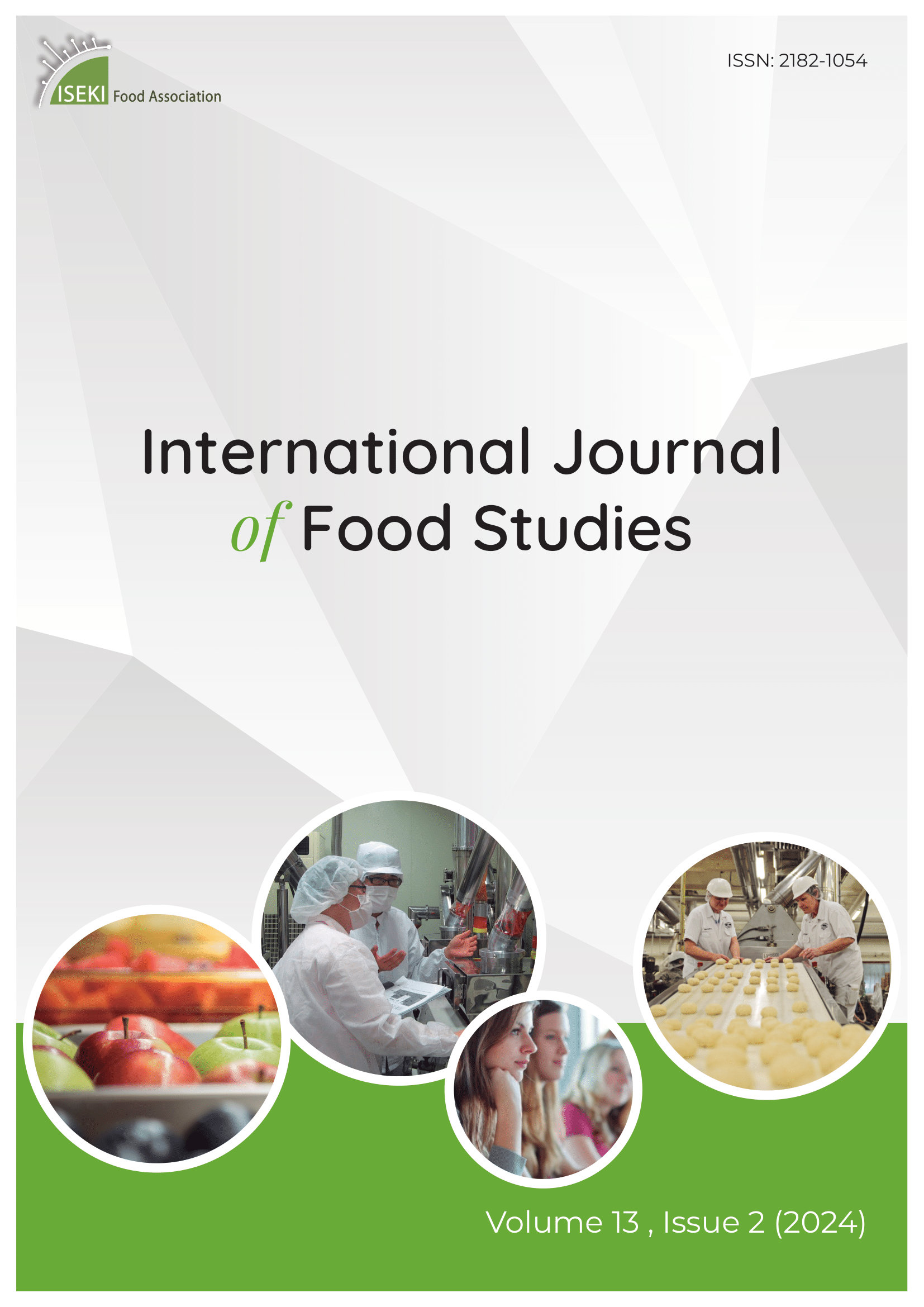Current issue
Edited by:
Yu Fu
Author guidelines
Editorial Policy
28
Issues390
ArticlesSPECIAL ISSUE 2024
Call for Article Proposals for IJFS Special Issue
BECOME A REVIEWER
We invite you to become an IJFS reviewer.
BECOME GUEST EDITOR
IJFS runs special issues to create collections of papers on specific topics. If you would like to run your own Special Issue, read more.
Archive
See all
Volume 13, Issue 1, 2024
Volume 12, Issue 1, 2023
Volume 11, Issue 3, 2022
Volume 11, Issue 2, 2022
Volume 11, Issue 1, 2022
Volume 10, Issue 2, 2021
Volume 10, Issue 1, 2021
Volume 10, Issue 3, 2020
24.02.2021.
Original scientific paper
Effect of Emulsifier Diacetyl Tartaric Acid Ester of Mono- and Diglycerides (DATEM) and Enzyme Transglutaminase on Quality Characteristics of Rice Bran Croissants
Rice bran (RB) is a good source of dietary fibre. Addition of rice bran into croissant interferes with the gluten formation of dough and hence affect the physicochemical properties of croissant. The effect of RB addition on physicochemical properties of croissant were determined by using 0%, 10% and 15% RB. Besides, additives such as emulsifiers and enzymes can be used in pastry to enhance the physicochemical properties of croissant. Diacetyl tartaric acid ester of mono-diglycerides (DATEM) and transglutaminase (TGase) were used respectively on 0%, 10% and 15% RB to investigate the effect of such additives on physicochemical properties of croissant. Increased % RB and DATEM, produced a significant decrease in specific volume, together with a significant increase in colour, hardness and chewiness. With increased % RB, TGase caused significant increase in colour, hardness and chewiness but significant decrease in specic volume. The overall moisture sorption isotherm curves of the croissant belong to the Type III isotherm, also known as Flory-Huggins Isotherm (J-shaped). The critical aw obtained from the Guggenheim-Anderson-de Boer (GAB) equation showed that the shelf life of croissants were not positively impacted by the addition of DATEM and TGase and the addition of RB did not cause any significant positive effects on quality characteristics of croissants.
Wan Zunairah Wan Ibadullah, Aw Ying Hong, Mahmud Ab Rashid Nor-Khaizura, Nor Afizah Mustapha, Z. A. Nur Hanani, Mohammad Rashedi Ismail-Fitry, Anis Shobirin Meor Husin
18.05.2021.
Original scientific paper
Applications of High Pressure Technology in Food Processing
Consumer trends towards shelf-stable, safe, more natural and free from additives foods drove the need to investigate the commercial application of non-thermal food processing technologies. High pressure processing (HPP) is one such emerging technology where foods are generally subjected to high pressure (100-1000 MPa), with or without heat. Similar to heat pasteurization, HPP deactivates pathogenic microorganisms and enzymes, extends shelf life, denatures proteins, and modifies structure and texture of foods. However, unlike thermal processing, HPP can retain the quality of fresh food products, with little or no impact on nutritional value and organoleptic properties. Moreover, HPP is independent of the geometry (shape and size) of food products. The retention of food quality attributes, whilst prolonging shelf life, are enormous benefits to both food manufacturers and consumers. Researches have indicated that the combination of HPP and other treatments, based on the hurdle technology concept, has potential synergistic effects. With further advancement of the technology and its large-scale commercialization, the cost and limitations of this technology will probably reduce in the near future. The current review focuses on the mechanism and system of HPP and its applications in the processing of fruit, vegetables, meat, milk, fish and seafood, and eggs and their derived products.
K. R. Jolvis Pou
24.02.2021.
Original scientific paper
Effect of Taro (Colocasia esculenta) Enrichment on Physicochemical and Textural Properties of Cake
Taro is a plant widely produced in tropical areas for its underground corms and it is used mainly as a vegetable. Its physicochemical, sensory properties and health benefits led to its use in value-added products. The cake is a high value-added bakery product and it needs a lower amount of gluten protein, therefore, taro flour (TF) was supplemented in wheat flour (WF) at different levels (10, 20, 30 and 40%). In connection with this, the incorporation of taro flour into wheat-based products has been reported to increase their nutritional and textural quality. The taro-supplemented cake showed higher mineral and fiber content, however, reduced caloric value. It was observed that taro supplementation reduced gluten and protein content and had higher oil and water binding capacity, therefore suitable for cake preparation. Taro cake had improved texture and sensory characteristics in comparison to wheat cake. It can be concluded that addition of taro for cake preparation improves nutrition and quality characteristics, therefore, it can be recommended to use taro for cake preparation.
Anuj Saklani, Ravinder Kaushik, Prince Chawla, Naveen Kumar, Mukul Kumar
18.04.2017.
Original scientific paper
Extrusion cooking technology: Principal mechanism and effect on direct expanded snacks – An overview
The snack industry is one of the fastest growing food sectors and is an important contributor within the global convenience food market. Nowadays snacks and convenience foods are also consumed regularly in India. Properly designed convenience foods can make an important contribution to nutrition in societies where social changes are altering traditional patterns of food preparation. Extrusion cooking as a popular means of preparing snack foods based on cereals and plant protein foodstuff has elicited considerable interest and attention over the past 30 years. Several studies on the extrusion of cereals and pulses, using various proportions, have been conducted because blends of cereals and pulses produce protein enriched products. Special importance is placed on the physicochemical and chemical modifications of protein, starch and dietary fibre. Extruded products can be categorized for a particular application based on their functional properties such as water absorption and water solubility index, expansion ratio, bulk density and viscosity of the dough. Therefore, the literature was reviewed for effect of extrusion processing on product parameters, and nutritional and anti-nutritional properties of extruded products.
AJITA TIWARI, Jha S. K.
18.10.2022.
Original scientific paper
Drinking coffee may reduce chances of developing Alzheimer’s disease: systematic literature review and meta-analysis
Coffee is a popular beverage, and it contains caffeine, a psychoactive substance. Consuming coffee may reduce the risk of developing Alzheimer’s disease (AD). However, the association between the reduced risk of developing AD and the consumption of coffee is controversial. Therefore, we conducted a systematic literature review and quantitative synthesis meta-analysis that included dose-response analysis on the relationship between the consumption of coffee and the risk of developing AD. Based on PRISMA guidelines, we analysed standard databases of journals published between January 1999 and May 2020. We included the two population-based cohort studies and one case-control study. All studies included looked at the association between consuming many cups of coffee, the amount of coffee consumed in milligrams per day and the risk of developing AD. The systematic literature review and meta-analysis had 1670 participants with follow-up years that ranged from 5 to 21. The consumption of moderate or 3-5 cups per day reduces the risk of developing AD. The pooled relative risk and 95% confidence interval of the 3 included studies were 0.63 (0.3, 1.54). Dose-response curve analysis appears to be U-shaped. The results of the forest plot showed that there is low heterogeneity between the studies. Plotting the funnel plot and the Galbraith plot demonstrated publication bias of the three included studies. More prospective and long-term studies have to be conducted in other countries to determine the exact risk of developing AD.
Sheba R David, Raheela Dilfer Zahir Hussain, Ihsan Nazurah Zulkipli, Rajan Rajabalaya
01.12.2018.
Professional paper
Stability of vitamin C in broccoli at different storage conditions
Nasser Al-Habsi, Sithara Suresh, Amani Al-Yhmedi, Marwa Al-Shoryani, Mostafa I. Waly, Mohammad Shafiur Rahman
18.04.2018.
Original scientific paper
Fermentation of tender coconut water by probiotic bacteria Bacillus coagulans
Coconut water is currently being considered as an elixir for patients suffering from diseases like dengue and malaria as well as chikungunia to provide hydration properties to the body. It has become a popular beverage for many people owing to its palatability and high mineral content. In this study, the growth, survival and fermentation performance of the probiotic bacterium Bacillus coagulans in coconut water was assessed in order to produce a novel non-dairy, probiotic beverage. The species was characterized on the basis of morphology, physiology and biochemical parameters and its probiotic attributes were assessed. Batch fermentations were carried out for 2 days at a constant 37°C, thereafter the samples were subjected to microbiological and chemical analysis. The results suggested that the specie produced lactic acid and was acid and bile tolerant. The pH and titratable acidity of probiotic fermented coconut water were found to be 4.4 and 0.53 % lactic acid, respectively. The viscosity of fermented coconut water increased significantly from an initial 5.13 mPa.s to 5.35 mPa.s because of the increase in soluble solids content due to exopolysaccharide production by B. coagulans during fermentation. Also, the overall acceptability score of probiotic coconut water was higher than tender coconut water, suggesting its feasibility for use as a probiotic beverage.
Aishwarya Singh Gangwar, Aastha Bhardwaj, Vasudha Sharma
18.10.2016.
Original scientific paper
Solubility of Stevioside and Rebaudioside A in water, ethanol and their binary mixtures
In order to investigate the solubility of Stevioside and Rebaudioside A in different solvents (ethanol, water, ethanol:water 30:70 and ethanol:water 70:30), supersaturated solutions of pre-crystalized steviol glycosides were maintained at different temperatures (from 5 °C to 50 °C) to reach equilibrium. Under these conditions significant differences were found in the extent of solubility. Rebaudioside A was poorly soluble in ethanol and water, and Stevioside was poorly soluble in water. Solvent mixtures more effectively promoted solubilisation, and a significant effect of temperature on solubility was observed. The two steviol glycosides showed higher solubilities and this behavior was promoted by the presence of the other sweetener. The polarity indices of the solvents were determined, and helped to explain the observed behavior. Several solute-solvent and solute-solute interactions can occur, along with the incidence of a strong affinity between solvents. The obtained results are in accordance with technological applications of ethanol, water and their binary mixtures for Stevioside and Rebaudioside A separations.
LILIANA CELAYA, Eugenio Kolb, Nicolas Kolb
01.12.2017.
Professional paper
Effects of heat treatment by immersion in household conditions on olive oil as compared to other culinary oils: a descriptive study
Carlos A. Nogueira-de-Almeida, Geórgia A. De Castro







